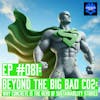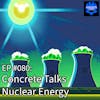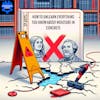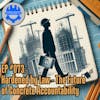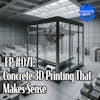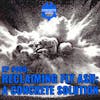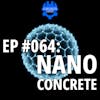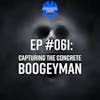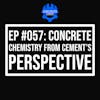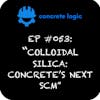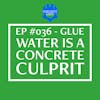EP #062: Dr. Concrete's Top 5 Concrete Tech
What existing concrete technology is making the biggest impact in the industry?
Join us for this episode of the Concrete Logic Podcast as Dr. Jon Belkowitz of Intelligent Concrete returns to the show to share his top 5 concrete technologies that are currently making a difference in the concrete industry. Dr. Jon always keeps Seth on his toes when he visits the podcast; this episode is no different!
Seth thought he was going to sit back and listen to Dr. Jon rave about his favorite concrete tech, but is caught off guard when Dr. Jon wants to compare lists. Without preparation, Seth provides his top 5 concrete technologies that have a common theme.
What technologies do you think are on their top 5? Is it 3D printing? AI? You'll have to tune in to find out!
***
Did you learn something from this episode? If so, please consider donating to the show to help us continue to provide high-quality content for the concrete industry.
Donate here: https://www.concretelogicpodcast.com/support/
***
Episode References
Guest: Dr. Jon Belkowitz | Intelligent Concrete | jon@intelligent-concrete.com
Guest Website: https://www.intelligent-concrete.com/
Producers: Jodi Tandett, Olivia Stocker
Donate & Become a Producer: https://www.concretelogicpodcast.com/support/
Music: Mike Dunton | https://www.mikeduntonmusic.com | mikeduntonmusic@gmail.com | Instagram @Mike_Dunton
Host: Seth Tandett, seth@concretelogicpodcast.com
Host LinkedIn: https://www.linkedin.com/in/seth-tandett/
Website: https://www.concretelogicpodcast.com/
LinkedIn: https://www.linkedin.com/company/concrete-logic-podcast
Seth: Welcome to another episode of the Concrete Logic Podcast, and I have a returning guest, y'all know him, he's the famous Dr. Jon Belkowicz, from Intelligent Concrete. We're Intelligent Concrete today, not Edyston, right?
Dr. Jon Belkowitz: Actually we're CIM.
Seth: Oh, yeah. C. I. M. Concrete Industry Management for folks that don't know that.
Texas State.
Dr. Jon Belkowitz: There you go. Yeah. Gotta get one of the guns out. Oh, I shouldn't say that in New Jersey, should I? No, they might be breaking down the door here in a little bit, just to let you know.
Seth: That would make the podcast exciting.
Dr. Jon Belkowitz: That would make the podcast exciting. And my collar is not popped. Just to let you know we haven't taken the dog on a W. A. L. K. Oh, that's his problem. And he is crying right there. So if you hear somebody crying, it's our dog who is giving us right now, but good morning, everybody. And Ryan, thank you for the shirt from Texas state and go bulldogs. Is that their mascot? That's not their mascot.
Seth: I don't think that's their mascot.
I can't remember what it is. I had them on the podcast too. I couldn't tell you what.
Dr. Jon Belkowitz: I don't know if it's an ID there. I'm just going to stop.
Seth: It should be like concrete, dudes or something.
Dr. Jon Belkowitz: Concrete dudes.
Seth: Yeah. That's probably not PC either.
All right. I know you got something to get to, so let's, not waste a whole bunch of time. But today we're going to talk about the top five concrete technologies. Dr. Jon's top five. Is that what we're going to call it?
Dr. Jon Belkowitz: No, that's not what we agreed to. And I've got witness. We could check the transcript.
Were you recording before we started this? No. Oh, that's a shame. I've got witness here that'll say that you're starting off with your top five. And then I'm doing my top five. Whitney? Oh, am I doing a top five? No. Seth is supposed to do his top five first, right? Okay, yes. See?
Seth: Oh, man. My top five. I don't even think I have five.
Dr. Jon Belkowitz: Listen we're not going to hold you to this. If you wake up at two o'clock in the morning, you're like, I should have said this. This is what's your favorite movie? Or what book would you bring on an island? You never answer it the right way when you're on the spot. But the ones that you do have when you're on the spot, they're the ones that are at your core that you can remember no matter what, or by accident.
Seth: Yeah. Gotcha. All right. You want me to go first?
Dr. Jon Belkowitz: That's what Whitney said, not me.
Seth: Okay. I, the first thing that pops to my head, the, I don't know how, I wouldn't call it new. It's newer and I think it gets more favorite, technology. Okay. I'd put out the, laser screed out there. That's my favorite.
Dr. Jon Belkowitz: Is that number five or is that number one?
Seth: I think we should count down from five. Go ahead. Laser screed. Laser screed. Reduction of labor also provides it the results of it provides a higher quality product. It also helps greatly with, the, The standards that some of these owners, clients have now that are out there.
Big box guys, Amazon and, such, they have high high FF and FL tolerances that you got to meet and really it I don't know how you would do it without a laser screed.
Dr. Jon Belkowitz: All you need is a bunch of guys on knee boards, one with the steel, one with the mag going over it, and that'll flatten it out.
Yeah. Yeah.
Seth: I'm sure they did it somehow like that. And place and finished folks just like everybody else. But I think to, to the extreme, they're hard to replace. Once these guys are gone, I don't see you a bunch of kids scrambling to. Place and finish concrete. So the labor force, right?
Yeah. And they're just cool. They're cool to watch.
Dr. Jon Belkowitz: There's logic behind that, man. Yeah. If your toys and tools are cool on the job site, and it helps you enjoy your job. I had a friend who used to work on satellites. He used to have a computer game That would have little robot arms that went out and fix satellites.
And you think he would like every kid's dream is to play. You have a video game that actually does something in outer space. And he's I remember the day he told me he was getting out of the field. I asked him why you have an amazing job. And he goes, what? You think I wake up every morning, jump out of bed, and go, SATELLITE!
And I swear, I shouldn't laugh, cause he, we were in a bar, he was crying, he was drinkin It's I hate this job. Like, how do you hate But, if you have a cool toy, and you love it yeah, I get to go on my laser screed, that's awesome! There's those dragon laser screeds, too.
Seth: Yeah. I got to use them the first time in the last four years.
Dr. Jon Belkowitz: Yeah. Great number five. Okay. What's number four?
Seth: What you gotta share your number five now.
Dr. Jon Belkowitz: Number five is really boring for me. It's lightweight concrete. And it's not the sexiest concrete out here, but the American Society of Civil Engineers at one point We're really big into concrete canoe and back in, what was it?
2001, 2002 timeframe. That's where I fell in love with concrete research. I'd already been doing concrete work for me as a young kid, but lightweight concrete and the concrete canoe competition started my, like I would literally at the air force academy, I would break into the lab at night with my buddy, Andy Gillis.
To work on, we had to remove, I'm not going to say how we broke in, but they would lock the lab up and not on purpose. This was the only time, like seven o'clock, eight o'clock at night for us to go down to the concrete lab near force academy has a huge effing concrete lab and we would get to work on lightweight mix designs.
And it was. It was awesome. I had a lot of fun. I had no effing clue what I was doing. I was just throwing materials in and waiting for it to harden and be like, dude, check it out. And I learned by trial and I just had the best time ever. And then we made the concrete canoe and it almost sank a couple of times.
And then we came back the next year and as we, our first year's canoe. It was called the POS,
pride of service, man.
So the next year we went we called it Troy's destroyer after a buddy of ours had passed. And then I can't remember what the next one was, but yeah, we really loved it. Concrete canoe is awesome. So that's my number five.
Seth: Lightweight concrete.
Dr. Jon Belkowitz: Yeah. And you could do so much with it blast absorbing use it for energy absorption for waves and then put some energy harvesting into it.
Title influxes, you can use it to control. There's so many blast absorbing we spent a long time. That's one of the first products we as a company ever developed with lightweight concrete. That was my first. I went from I went from lightweight concrete for the concrete canoe to lightweight concrete for blast absorbing properties.
And that was one of our biggest breakthroughs that really what's got us our funding as a company to start off. And we sold one of our major mixes to. Certain agency years and years, 15, 15 years ago. So that was our first project ever. And it was basically the technology that I had been working on when I was working at Lafarge, I had this big closet huge closet right in the front, like the weirdest apartments, the grand Lowry lofts.
And I turned it into a little research laboratory. And I would call companies that how all these different 3M. Other companies had lightweight aggregate and then I'd buy cement. I asked some of the sales folk for samples and I would have a Hobart mixer, which really was a kitchen aid and mix up samples in my apartment to figure out these mixes.
And that's when I was learning concrete mix design at Lafarge. So I was using the techniques I learned at Lafarge to get into lightweight for blast absorbing. Then I worked at the U S army core on identifying the properties and University of Denver had a blast range. So yeah, lightweight concrete. Your turn.
Seth: All right. I should have disclosed that maybe these aren't in order, but I'll try my best to keep them in order. I'm going to go with not, it's not necessarily concrete, but it goes in concrete welded rebar mats.
Dr. Jon Belkowitz: Really, that is. Why? Like the rollout ones?
Seth: No, not wire mesh.
I'm talking about rebar so typically again going back to An Amazon project that I was on they wanted you to tie a bunch of number fours and fives for slab on grade reinforcement, which is, that's a lot of ties for rodbuster to do. So we converted them, to welded rebar mats, which those are prefabricated in a shop and then shipped to you in big mats.
I'm trying to remember what the size of these things are. They're massive. They're like six or eight foot wide by 14 sheets. They weigh a couple hundred pounds each, but it's basically you're throwing a mat of rebar down that's already pre tied and it's pretty cool technology.
I would consider that technology under a prefab kind of tech.
Dr. Jon Belkowitz: To some degree, if you look at your list from before reduction of labor force, higher quality product help regulate stricter standards there's a, theme between your first one and your second one. Yeah. That's what I like to do.
I like to look at people's lists and then try to figure out, just like your hats behind you and your paintings, I like to see the theme and the trend and things to describe you as a person. Okay, have you seen the same thing, the welded rebar mats, but in a carpet roll? And they roll it out on the job site?
Seth: I've seen that, I personally haven't used it on a job, but I've seen videos of that and I was talking to somebody in Europe about it that's trying, to get over what was that guy BAM or something like that?
Dr. Jon Belkowitz: Yeah. It was so amazing, yeah. So it's literally the same thing that you're saying, but it was a carpet roll.
Seth: Yeah. Yeah. Yeah. When you said rolls, I went straight to the, that small wire mesh stuff that you used to roll out, but that it comes in sheets too now, but yeah, no, I've seen that. That's pretty cool. Yeah. Yeah. I talked to that guy and I got to catch back up with him.
It's been a while since I talked to him.
Dr. Jon Belkowitz: Right on. My number four modeling and simulation.
Man, my heart goes beat, beat, beat, especially with our if you look at the basics, hold on a second, there's a lovely book that goes into the math behind our models and our simulations, right? And I have a wonderful presentation on how one of these software packages work, but we said no, no product names.
You need to grab this book.
Seth: Okay.is that a book you got to have a PhD to read or...?
Dr. Jon Belkowitz: I was just about to say, no, because I did not have my PhD when I read this book. But what, and you don't, nobody's going to test you on this information, but what it does is it gives you the background as to. You have these software packages, these modeling software packages, everything from bridge oscillation for earthquakes to the size of a girder or beam for a house based on the load to concrete mix design, curing in different situations for both phase development, as well as mechanical problems.
That type of stuff. The problem is you went to reduction of labor force. I'm going in the same direction that we have a reduction in labor force. We have a reduction in labor force everywhere. Listen to Mike Rowe and he goes when they say they should have sent a poet when it's talking about the reduction, not only in the labor force, forget the labor force people care, right?
You and I aren't perfect, right? We're students. We're trying to become better. Shoot. I just screwed up on a series of projects in the last few weeks That's why they put erasers on pencils, but there's less of us out there who care so we have to recognize other tools. Modeling and simulation. I'm looking at pipe flow.
Modeling and simulation. I know that doesn't sound exciting, Jon. I get it. You have every right to say that, but I didn't say it. That's the general public. That was not you. If it was gonna be you, I would have said, That's not how I say it. Like I would have done that voice.
That's more the modeling and simulation software out there is so powerful that if you just do a little bit of, research out in the field or the lab, or the combine the two, and you can find a. What's the word I'm looking for a consistency between the data, like now all of a sudden, what would take you 50 days, 90 days, two years, you can model and simulate and get an idea of what you want to do.
Will it have a positive, a general idea, a modeled idea, but, or simulated idea, excuse me. In a short period of time. And what we do is a lot of underwater abrasion for pipe flow, right? And as it turns out, water pipes, concrete water pipes do great until there's a certain amount of turbidity, right? And whether turbidity is rocks, I just got the meanest stare from my dog right now.
He is he is disappointed. So if there is a little bit of turbidity, now all of a sudden we start wearing and tearing the rock or the concrete faster, and then we start ripping and stripping the rock, and then it goes to hell. We can simulate what that looks like, the profile, the, what is that, n value, that epsilon value that you have in your turbidity equate or your Reynolds number equation.
Or your, what is it, your frictional flow equation, your H of S, F, you know what I'm talking about? I don't. Your head friction from water flow takes into account the Reynolds number, which is a water flow number that goes back to whether it's laminar or turbulent flow. There's a certain value in there.
It's called Epsilon that goes through the type of water you have, like good water, water, clear water, or deer carcasses or soil in your water. The more turbidity, the more it's going to tear down your, concrete. Now, if we can connect that to tests that we've done in the field or tests that we've done in the lab on certain concrete mix designs and say, Hey, We know at this, in this times under turbulent flow, this is what happens to our concrete.
We put that into the model. It'll change us. It'll tell us how the water flow will change based on the feel of the concrete because of that abrasive wear. And that's all mon, we could do the same thing for 3d printing with the flow of the concrete through the pipe. Tyler lay did a similar thing where they tested.
How air changed through a pipe, right? Now you can create a model or simulation in a software package or software package in a model to tell you how different mixes will interact based on the change in bends. So there's so much you can do, but our industry is always nothing will replace what you do in the field making concrete.
No Sherlock, but we just don't have that many people, so we need to be comfortable with different tools.
Seth: Yeah. Does that modeling, could you take say a project and model what, if it would... I guess I should make this less complicated. Say, you have a project that's reinforced with traditional rebar and you wanted to see if you could reduce the amount of rebar in, in the structure and put post tensioning cables in place or some other reinforcement. Is there models modeling for that?
Dr. Jon Belkowitz: So many models. All right. B U T, B U T, This is the reason why you have to get into like this. Yeah, because the problem is, and I love saying it like that. The problem is garbage or good data in to bad software equals garbage out.
So if you don't know, like you could be sold a real lemon. I don't know what other word to use, but a real piece of crap software that when you're, doing software or modeling. What you're doing is you're simulating what would happen in the real world by using equations with the data you've given them based on a certain amount of parameters, right?
If you set up the parameters wrong or your conditions are not set up the right way it doesn't matter what you put in, you're going to get garbage out. So understanding how these models work is important because if you don't... If the designer of the model screws up the logic it doesn't include the right factors or doesn't, give you a chance to change up factors.
You might be consistent. That's a great thing about models. You put data in, you will consistently get data out, but you can get consistently wrong. So that's why it's important to do we're releasing a concrete mixed design software package. And it's not for the everyday homeowner, right? Oh, Jon, why don't you make it?
Because I don't deal, that's not what people say, nor is it how they say it. My dad said it like that, or not my dad. My dad is actually all for it. He normally says stuff like that. I had a buddy who said I don't know concrete mix design. So I don't understand it. I'm like, great. I don't want you to buy this.
It's not for you, right? This is for people who understand concrete. But don't know how to design it or have a hard time designing it and just want to backup check. And you think it's 99 cents a month. It's a software package. It's a model and it's simulating what's happening in the real world. Can you use it?
No, it's a benchmark, right? And all it is a bunch of equations that are generating a response based off of User input. So modeling simulation, fricking love it. Number three.
Seth: My number three, I will go with concrete sensors, the sensors you put in concrete that measure the temperature of the concrete.
So before I think, I don't, can't remember if I'd done a podcast on it. I think I have but so essentially what you do is you make a bunch of cylinders and you break cylinders that one day, three days, seven days, 28 day, you measure the temperature and then you correlate that with the temperature and your, concrete in place.
And that tells you the strength of the concrete, which is pretty cool. The first time I used it was 2004 and I can count on one hand, how many times I've used it since, but it's, pretty cool technology.
Dr. Jon Belkowitz: Why, do you think? The industry doesn't want to adopt it versus why they should adopt it.
Seth: They're just used to making cylinders on site and dragging them to the lab and breaking them and going with that.
Dr. Jon Belkowitz: Putting a thermometer in there. That's my temperature. I'll put it in the slab if you need me to. We can leave it in there. Yeah.
Seth: Yep. And you can. Yeah, the cylinders, I think we beat up cylinders a bunch on the podcast, a bunch of episodes, but yeah, you can make those cylinders break at whatever you want them to.
And when they're mishandled, they never tell you what really is going on.
Dr. Jon Belkowitz: Wait a second. Don't blame the cylinders.
Seth: I'm not blaming. I'm not blaming the cylinders. I'm saying that there's many problems with the, way we typically test the concrete.
Dr. Jon Belkowitz: I'm sorry to say this, but, and I don't mean to say it this way, because I'm being disrespectful to myself, greater people made greater concrete structures that have outlasted our great grandparents.
With lesser technology. Yeah. And to demonize, I'm in love with cylinders.
Seth: Of course you are. You're a lab guy.
Dr. Jon Belkowitz: No, I'm not. I'm a field guy. I've gone to the lab. Yeah. Where I started out as a 14 year old kid was out in the field. So I went to the lab. But for Lafarge North America, my ass was up at four o'clock in the morning grabbing aggregate for under the way up hopper.
In the plant and following trucks out there and taking samples and making sure water wasn't added. I love cylinders because they are a great tool beyond what the standard tells us. What you've just told me is. And I'm using, I'm cherry picking your words. So I do apologize, but people don't care of it.
They're mishandled. Whatever job site you were on where that happened, somebody didn't give a about doing their job. Excuse me. I apologize. Somebody didn't care about their job. I won't cuss again. I promise I'll do a better job. And that's Dataset that's important to have that doesn't mean that the concrete was bad and we have you know ways of Swiss cheese in the concrete and that's another discussion.
That's not how we make Swiss cheese, by the way we don't drill holes into Swiss cheese to make Swiss cheese, but There are ways to determine if the concrete is really good or not, but I agree with you that happens, that doesn't mean it's not good data. I just don't like the idea of demonizing something that is at the foundation of concrete mix design.
Granted it's not the concrete that's being placed. It's not supposed to be. It's supposed to be a metric. That's all it's supposed to be, a tool that we use to determine how did we do with, because all we are is a delivery service on the ReadyMix side. We're transportation. It just happens to be that we transport a perishable material as a window.
If you don't get in that window, you're up the creek without a paddle. What we need is a third party to altruistically, they're getting paid, but altruistically tell us How did we do? We did bad. All right, tear it out, guys. Something we screwed up something or timeout. And people are trying to automate cylinders.
And the unfortunate reality is you're just not allowed to do that yet. Unless you have a PE stamp in. That you can do that. But a lot of sensor folks and I'm in love with sensors. I think they're great, but a lot of sensor folks are saying you can replace. Do you mind sending that puppy outside? He's mad at you.
He's not mad at me. They're trying to literally everything you've said brother has gone back to the reduction in labor force. A higher quality product, right? Sensors were never meant to replace concrete cylinders. I know a lot of people are selling that. Saves you money, saves you time. But ASTM C1074 stipulates, Maturity of Concrete, stipulates that you need to have some type of secondary method, whether that's concrete cylinders, cast in place concrete cylinders, a Windsor probe, or maybe that was taken out in a rebound hammer, but You need to have something that's a secondary, gives you secondary information on what's going on because maturity and temperature Is only correct to a certain degree.
It's like a model in the simulation. You can't just use modeling and simulation, right? To go out to a job site. We have to do some concrete mixes. So that's my only thing but I understand why you like concrete sensors from your side I just think that we need to hold our practitioners, our contractors, our testing firms to a much higher standard.
And that's another conversation.
Seth: That's fair.
Dr. Jon Belkowitz: Okay. You ready for mine? Yep. You could beat me up on this one. Okay. Okay. Hydrogels, love hydrogels. Love hydrogels, hydrogel. Yeah. Fucking everything in concrete is a flipping hydrogel, right? The Calcium Silicate Hydrate network. It's a ham and cheese sandwich. It's a hydrogel, like the makeup of it when you look at it on a nano scale, looks like a ham and cheese sandwich.
Where your piece of ham is a calcium oxide layer. Then you have your cheese, two pieces of cheese on either side of your ham, which is your silicone tetrahedron. And then you have your bread, which is, so this is pairing silicone tetrahedron, and then you have bread, which is your pairing silicone tetrahedron, and then you could do a Dagwood Bumstead sandwich and put a little mayonnaise on top of it, and another sandwich on top of that, and you have stacks.
Of calcium silicate hydrate. That's a hydro gel, right? Alkali silica reactivity. It's hydro gel, right? The stuff on that we work on with colloidal silica to, to rejuvenate Brit or damaged and deteriorated concrete. is a flippant hydrogel. Even calcium oxychloride formation, to a certain degree, is the pacification layer over steel is a hydrogel.
Seth: And what, do hydrogels do for concrete?
Dr. Jon Belkowitz: They destroy concrete as an ASR gel, the depacification of rust over steel and they can be used to heal concrete. We're an industry that understands so little about them. The medical industry has been using them for decades. And we follow suit with a lot of the medical industry.
It turns out our human body solution is a similar makeup to the concrete pore solution. It happens to be that way. So there happens to be some similarities between the way that we can work with concrete. Look at the Department of Defense just released 10 million to the University of Utah for the U.S. BRACE DARPA program, which BRACE stands for Biological Remediation of Aged Concrete Edifices. And they're basically using the same vascular systems that we have in our body to try and repair concrete.
Seth: Huh.
Mind blown.
Dr. Jon Belkowitz: We have a 42 trillion dollar debt on concrete that needed to be replaced yesterday. Structurally deficient concrete, and that's only looking at bridge, dams, locks, levees, spillways, like the important shit, right? And the reality is we can't replace it. We don't have the people, resources, and we don't have to get Mike Rowe's poetry into it about our labor force, but we have not yet automated construction as they've done in the movie like Tomorrowland with George Clooney.
Terrible movie. We just haven't done that yet so that we can replace structures quickly a direction of using hydro gels to biologically rejuvenate aged concrete. Yeah. Now, there are companies that make a product that Is the kryptonite to concrete, because that's what we're talking about. There are fake companies out there that they say they have the same thing.
And that was my big discussion with different entity folks. How do you tell the good stuff from the bad stuff? Because again, ASR is a hydrogel, bad stuff.
Seth: Yeah.
Dr. Jon Belkowitz: What's your next one? We're running out of time.
Seth: I guess go with 3d scanning and building information modeling is so the, that technology was around but it wasn't really used for concrete till I guess the last handful of years. It's really mainstream we've used you've, people have heard BIM, what BIM is, but it just makes it so much easier to visualize what a building looks like, what a structure your building looks like.
It makes it a lot easier on everyone involved with the project to see what the end results supposed to be. And also with the 3D scanning, you can immediately see and even there's some guys out there that are scanning. And we're, doing that to Baker's doing that is scanning concrete while you're placing it down.
So you can see if there's any issues with it being flat and stuff. And then there, you can scan in place even going to the other trades like MEP mechanical electrical plumbing conduits and pipes that are sticking up, you can go out there before you pour concrete, scan it, and then compare it to what the plans and see if there's a issue out there.
It's a fantastic technology.
Dr. Jon Belkowitz: I want to buy one of those. I know exactly what you're talking about. And I spoke to that guy and that lady and I fricking want one so badly. Come on. Wait, it's only like $35,000 and $1,200 a month for the software package. Like totally. She's like, how would we use it?
And that doesn't matter. It's cool. It makes me jump out of bed in the morning.
Seth: Yeah, no, yeah, it's, it just makes. So much. It makes so many things. We could sit here for the next half an hour and list all the things that it does for, us. But Yeah.
Dr. Jon Belkowitz: Alright, so you realize it's all going back to this reduction of labor force, higher quality, like everything you've chosen so far has gone back to that some form or fashion.
Seth: Yeah. I'm in concrete construction, so that's a bit, always top of mind.
Dr. Jon Belkowitz: Understood. Alright, my number two, you ready? Yep. Colloidal silica for concrete. Okay. I'm going to fall out of love with that.
Seth: I'm just going to jump and say that was my number one so we can talk about why for each one of us for, me, and I'll let you, I'll let you say you're going to talk more about it than I am.
I just got my hands on some in the last couple of weeks. Great stuff. I'm doing I've shared with folks, I'm doing concrete countertops at my house and just playing around with it on that. Yep. So I, what I'm more most interested in with colloidal silica is internal curing, getting rid of any wet curing requirements on a project.
And also the chemical cures that we use right now, I'm not a fan of. I don't think people use them like you're supposed to, and I don't think we're properly curing concrete. So I'm, I really liked the aspect of internal curing. That's why I like colloidal silica.
Dr. Jon Belkowitz: I'd love to do a lot of research.
And I even have a paper that we're writing and publishing that if you promise not to share it, I'll send it to you for an early, it's almost like Harry Potter adventure. It's like just riveting. So just riveting on colloidal silica and internal curing. It's, one of my favorite subjects about the technology.
Seth: Yeah. Yeah, that was, I didn't mean to jump ahead, but since you're number two is my number one and I think it's just honestly it's my number one at this point. My opinion of it is still I'm on the fence because I haven't used it in the field and seen seeing what happens. I have my little project at home and they'll show me a little bit of it.
But I think that is the technology that's top of mind right now because it's the newest thing that I've looked into.
Dr. Jon Belkowitz: And I love it because I, this is not a new thing for me. I've been studying this stuff for I keep saying a decade, but I think it's been 17 years now.
So it's been 17 years now and I am deep into the research. I, the plan is for me to start a post doctorate this month furthering my education, answering more questions that I want to answer about colloidal silica.
But we're barely scratching the surface, man. It's almost like how we started with, it's the same conversation about starting with cement in 1847, right? When Joseph Ashton, like first, Really created this patent of all you got to do is add water instead of adding all these other things or just getting one type of natural cement from some part of Pennsylvania.
It was to me, colloidal silica is really where I found my home for research and development. I felt very comfortable in early on. People would just laugh at me. I had a bribe people to send me samples. I annoyed the shit out of people when I asked for samples. So it's been a very long journey and I, don't think I'll ever stop.
Once I retire from concrete, I'm sure I'll still keep reading about colloidal silica. So yeah, I love it.
Seth: Yeah. And there's, many things it does beyond internal curing which I think there's a lot of products that we apply and put in concrete right now that it can replace and do many more things.
So there's a possibly a cost reduction and labor reduction there as well.
Dr. Jon Belkowitz: Yes. And yes. And that always goes back to you for that reduction in labor. That's awesome. But it's also, let's say fly ash. I fully embraced that class of fly ash that we, you and I started using when we were younger is dead.
What we have right now is a, bastardization of what we used to call fly ash. And that's the chemical and physical properties. I'm not, it's not my opinion. That's just numbers. Using colloidal silica with what is now considered class of fly ash makes it seem like what we used to get in the late nineties, the early two thousands, the poor man's water reducer the pozzolanic reactivity that you want to, and that's when you're combining the two.
So I, I think that for engineers that aren't comfortable using class, anything but class of fly ash, because that's what their predecessor and predecessor used. Great. They can use colloidal silica, small amount plus the fly ash. That's not really fly ash, but keeps them comfortable.
So yeah, we run a huge project, 300 yards in Colorado doing that for what was Martin Marietta and that's literally all we did. Yeah.
Seth: All right. We skipped to my number one. What's your number one?
Dr. Jon Belkowitz: My number one, it's gonna sound hokey, my number one is concrete. My number one is concrete. It's my favorite part about concrete technology.
And if you want to argue, it's not a new concrete technology, I dare you to ask any ready-mix provider about their day to day activities. Because even that 3,500 PSI exterior flatwork mix for a driveway is brand new every flippin morning, whether it's the cement chemistry, the gradations the temperature of the day, the person behind the batch computer isn't wearing the right plaid shirt, whatever it is, making concrete is not the easiest of occupations out there because It can be an ever changing, it's more of an art than a science.
And as you have pointed out, the reduction of labor force, we're trying to automate a lot of things. AI software can't replace a fighter pilot. AI software, in my opinion, cannot replace somebody who is designing and managing concrete 100%. There always has to be. Some human element to that.
Seth: Do you think that F-35 that we lost this week was flown by an AI?
Dr. Jon Belkowitz: It ain't my business anymore, man. I'm out of that business. I retired from that business.
Seth: I like where you ended with with concrete. I, agree. And Yeah. And concrete can be an answer to more than just building things too.
I think. But we can talk about that on another episode. Cause that's another hour conversation.
Dr. Jon Belkowitz: There was one other conversation that we started about I think it was about responsibility in the field. And that's something I'd rather talk about. I want talk colloidal silica with you. And dive deep into some of the research and the concepts, but I think responsibility in the field.
One of the things from my post doctorate is they asked me to put, what do I want to be when I grow up on there and I want to be part of the NCEES board. I want to develop a P. E., a professional engineering exam for concrete. There's one for, water, for transportation, for soils. Frickin soils, they have a frickin stupid P. E.
And by the way, I'm a geotechnical engineer, a licensed P. E. for stinkin soils. Why wouldn't we do it for concrete? Concrete is so much tougher and I already see the whole breakdown. 80 questions, baby. Or excuse me, 40 questions.
Seth: Yeah, that sounds good. We could start the Dr. Jon's school of concrete.
Sounds awesome. All right, man. As always, I appreciate you coming on the show. Folks can reach out to Dr. Jon Belkowitz via LinkedIn, Intelligent Concrete, Edyston and anywhere else I forgot.
Dr. Jon Belkowitz: Those sound good. That's enough. Yeah. Any questions? Just not on Sundays. That's family day.
Seth: You, you say that I get texts from you.
Dr. Jon Belkowitz: Whitney's sitting right here, man,
I'm gonna get in trouble.
Seth: All right, man. And thank you. And everybody keep it concrete till next time. Thanks.
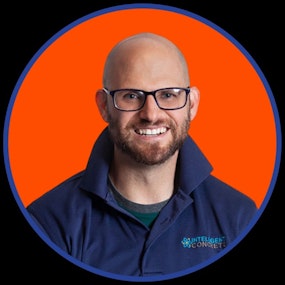
Dr. Jon Belkowitz
Jon Belkowitz is the Director of Research and Development at Intelligent Concrete, LLC and Chief Technical Office for Surface Tech’s Concrete Division. Before forming Intelligent Concrete, LLC, he served in the United States Air Force from 1996 to 2006 specializing in Civil Engineering. His tour of duty introduced Dr. Belkowitz to a wide variety of concrete types and uses which were dependent upon the engineering practices of different host nation forces, developing nations, and disaster repair initiatives. Jon has worked in private testing laboratories on structural engineering proposals and materials development projects to include the application of nanotechnology in concrete. Dr. Belkowitz has worked as a consultant on projects in the United States, India, Turkey, Africa, Italy, and Germany.
Specialties: - State of the Art Testing and Consulting
- Design and Development of Concrete
- Marketing of New Technologies
- Standardized Tests for the Lab and Field
- Forensics Analysis on Failed Structures
- Educational Seminars - Basics to Advanced








